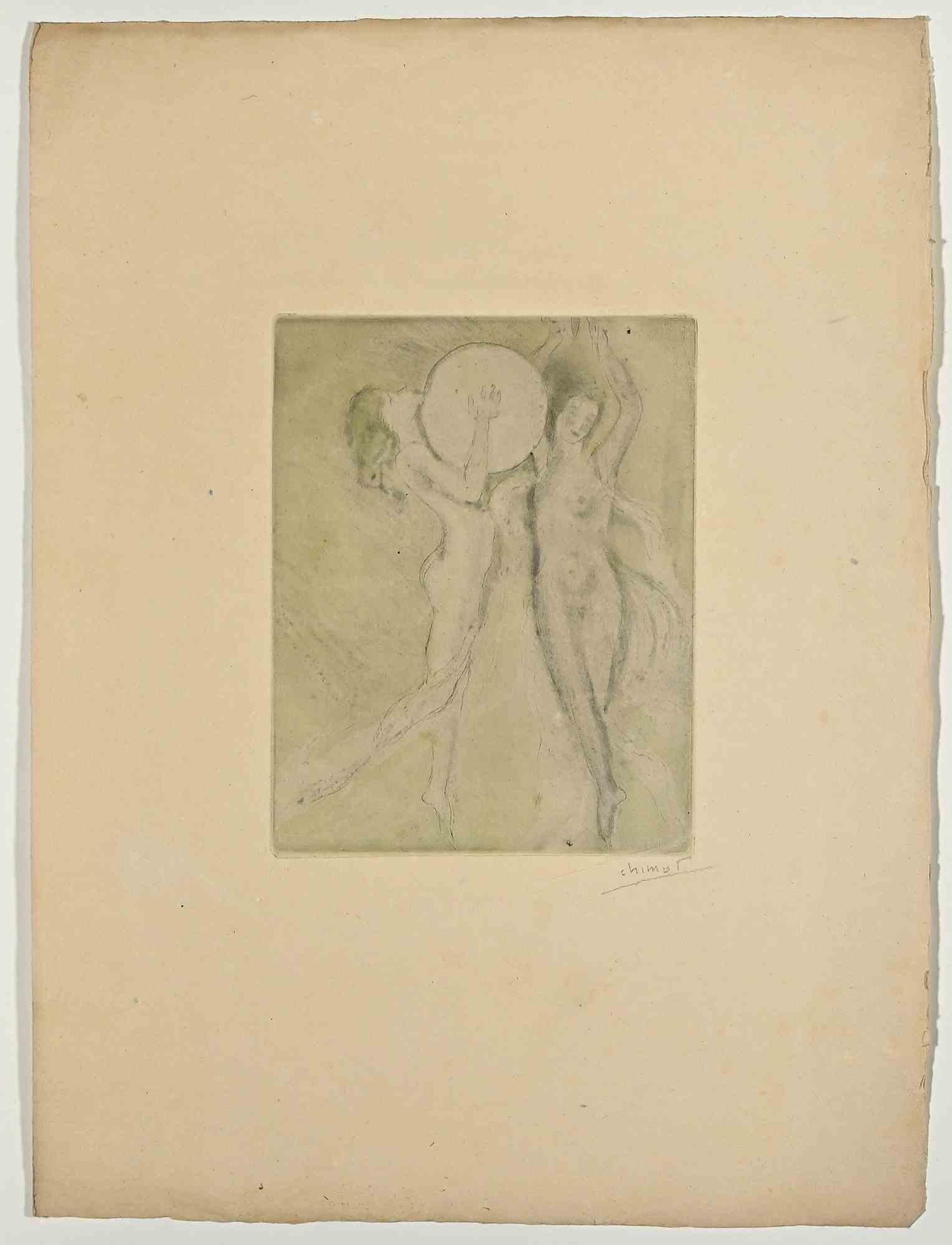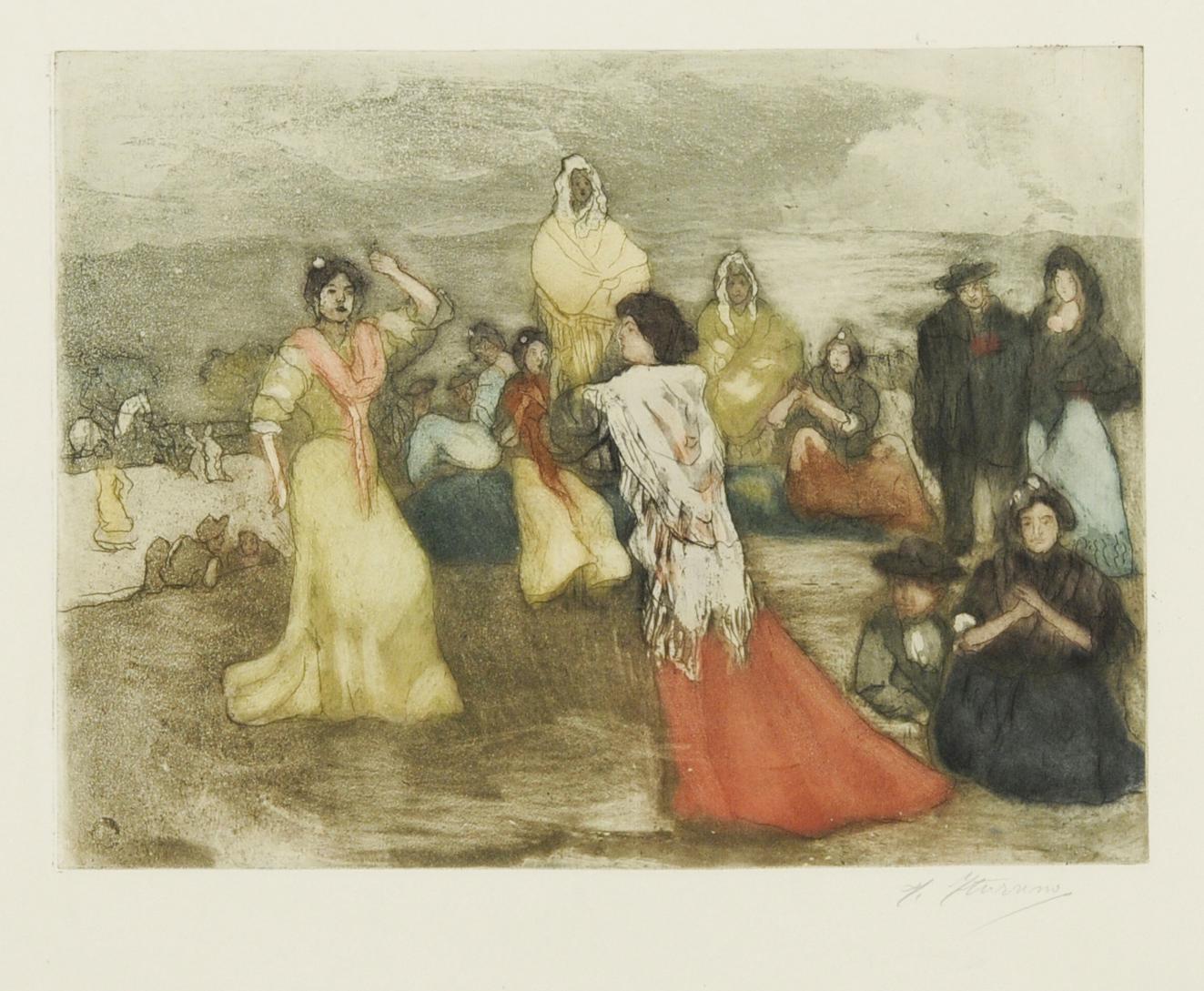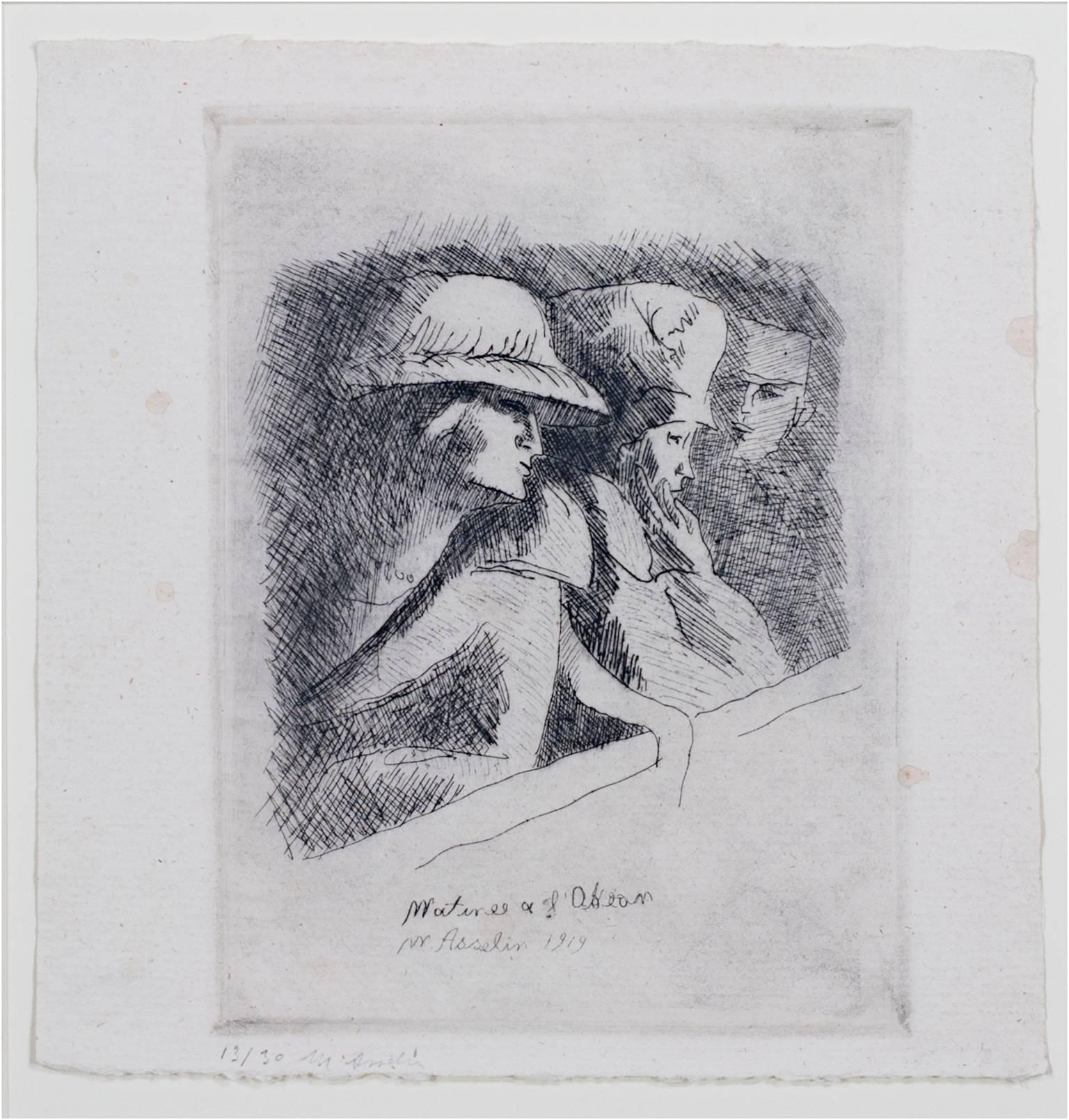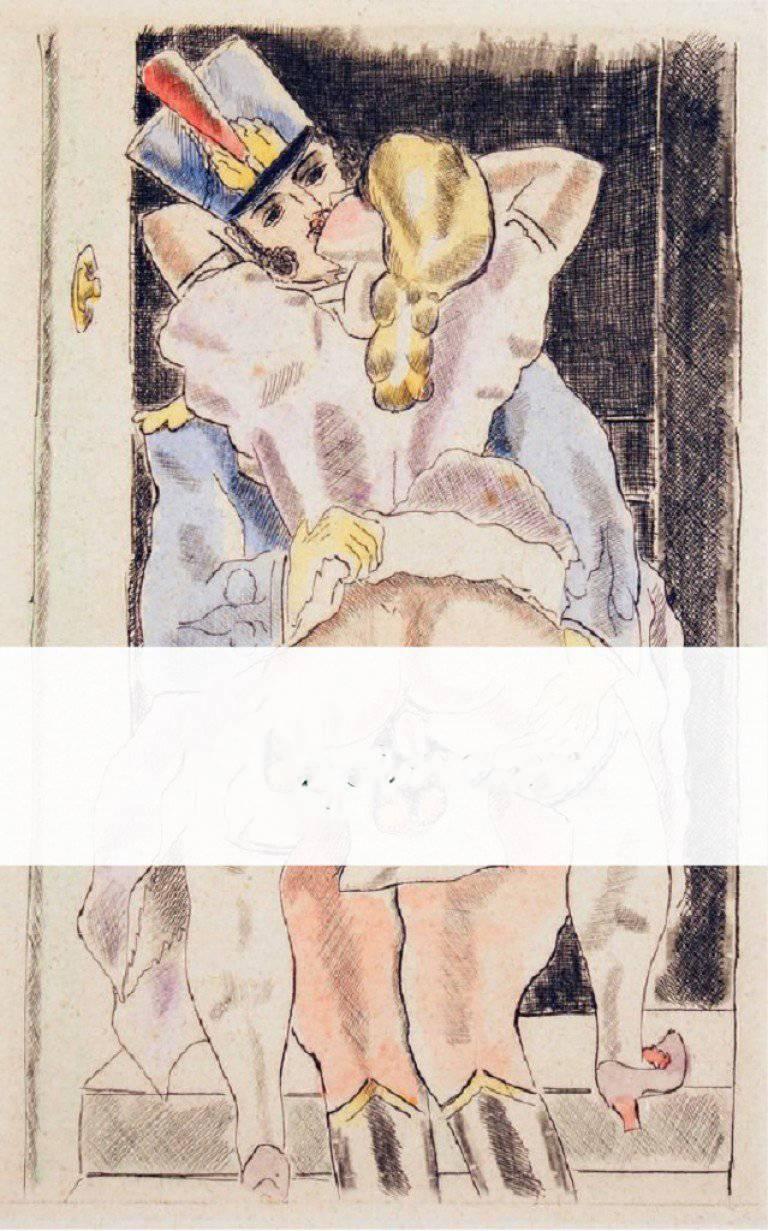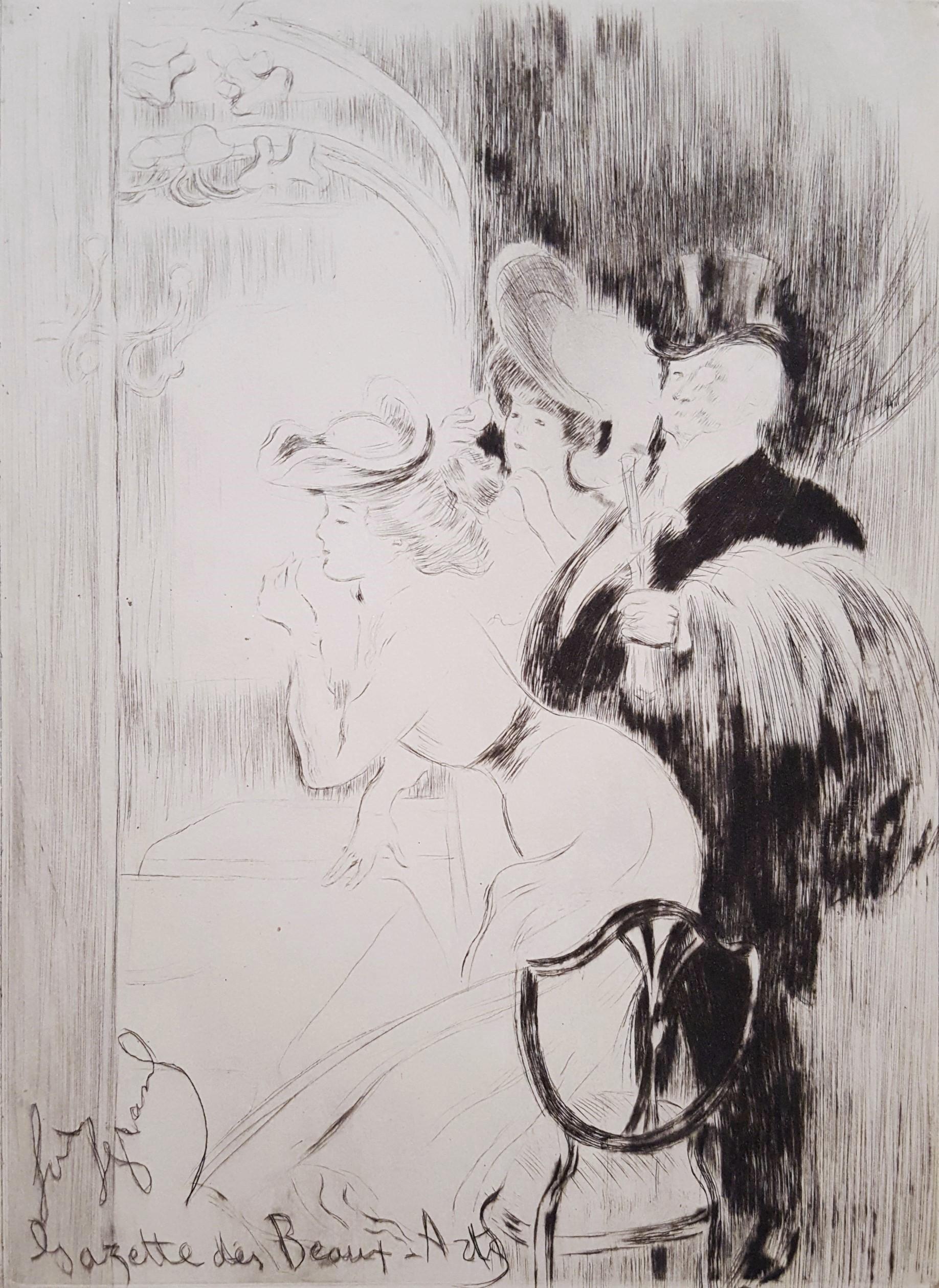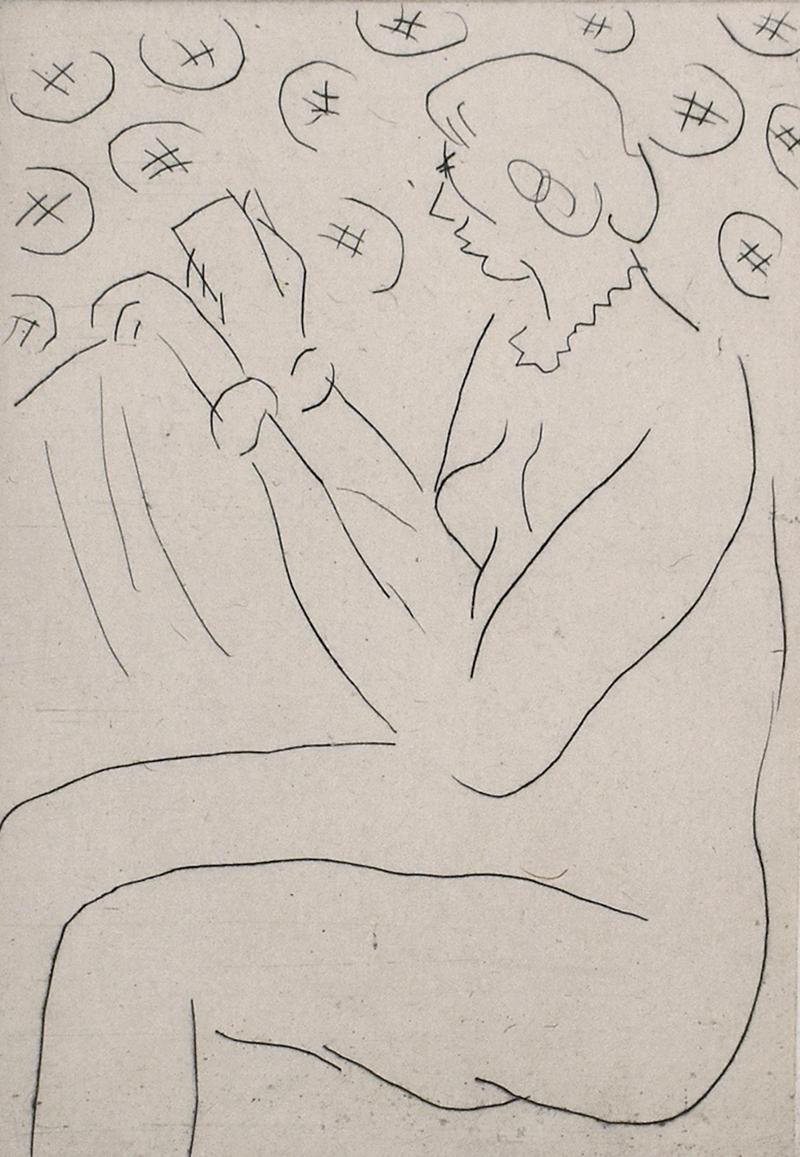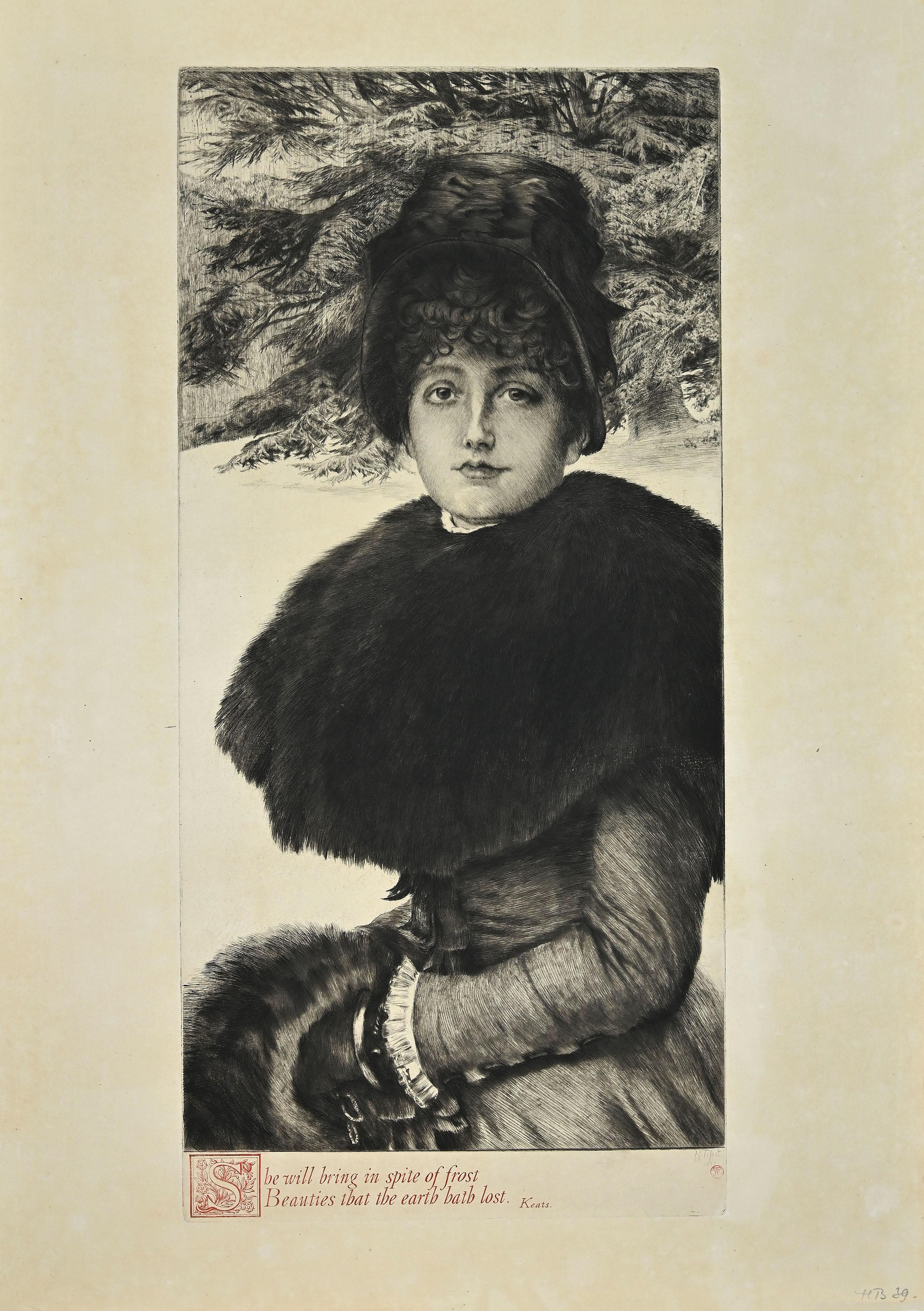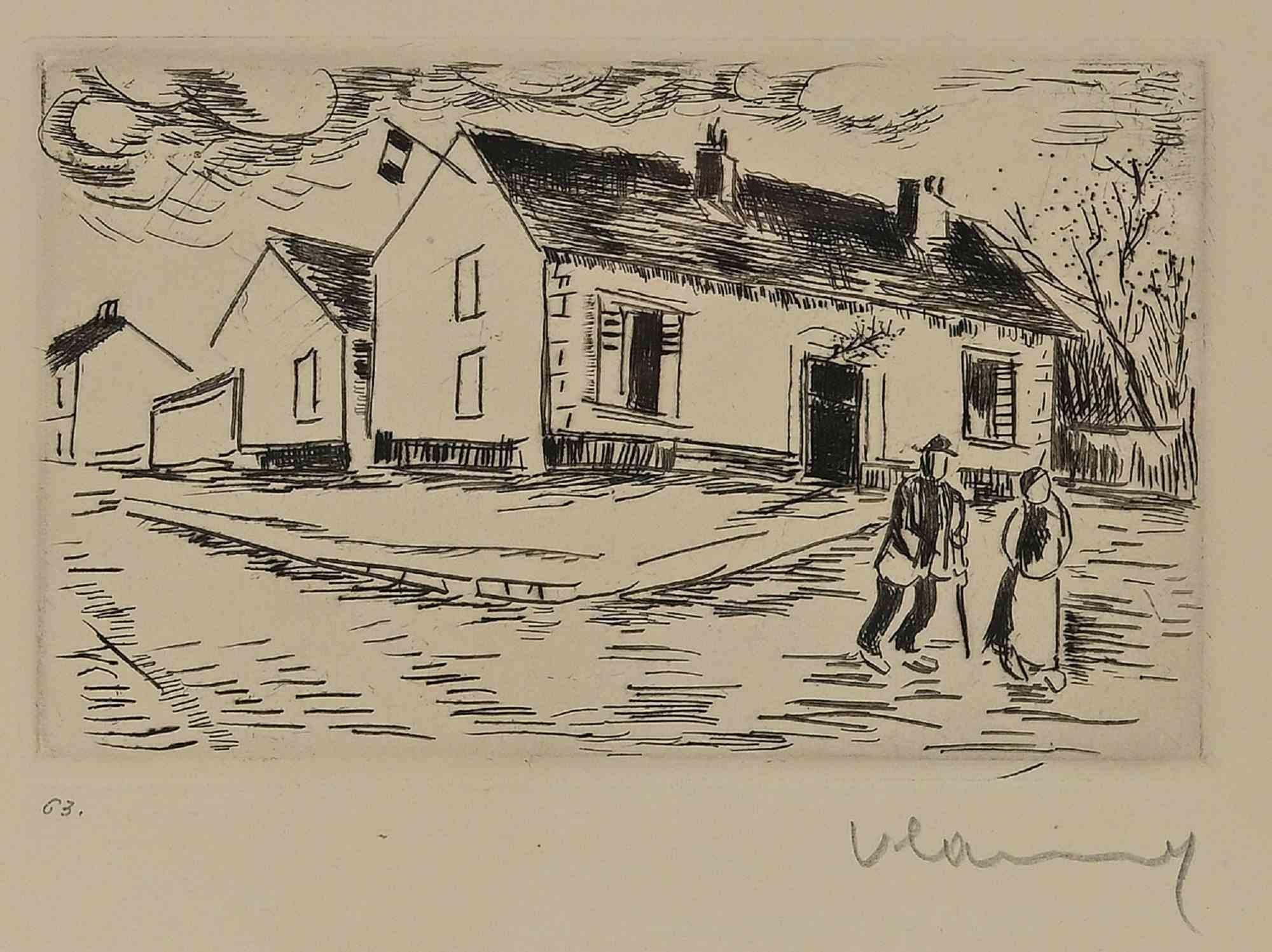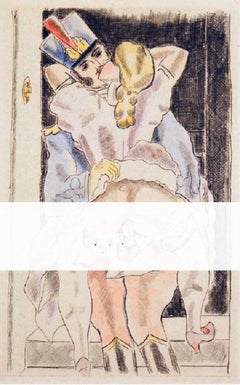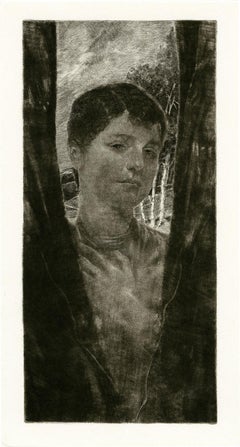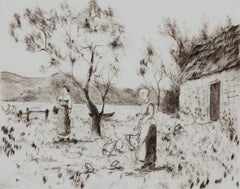
Lisière du Petit Bois, Ostende - Etching by James Ensor
James EnsorLisière du Petit Bois, Ostende - Etching by James Ensor1888
1888
About the Item
- Creator:James Ensor (1860 - 1949, Belgian)
- Creation Year:1888
- Dimensions:Height: 6.3 in (16 cm)Width: 9.85 in (25 cm)Depth: 0.04 in (1 mm)
- Medium:
- Movement & Style:
- Period:
- Framing:Framing Options Available
- Condition:Insurance may be requested by customers as additional service, contact us for more information.
- Gallery Location:Roma, IT
- Reference Number:Seller: J-671931stDibs: LU65032481571
James Ensor
James Ensor is a Belgian painter and printmaker and an important influence on Expressionism and Surrealism. Ensor's early works, such as Russian Music (1881) and The Drunkards (1883), depict realistic scenes in a somber style, after which his palette subsequently brightened and he favored increasingly bizarre subject matter. Such paintings as The Scandalized Masks (1883) and Skeletons Fighting over a Hanged Man (1891) feature figures in grotesque masks inspired by the ones sold in his mother's gift shop for Ostend's annual Carnival. Subjects such as carnivals, masks, puppetry, skeletons and fantastic allegories are dominant in Ensor's mature work. Ensor dressed skeletons up in his studio and arranged them in colorful, enigmatic tableaux on the canvas and used masks as a theatrical aspect in his still lifes. Attracted by masks' plastic forms, bright colors and potential for psychological impact, he created a format in which he could paint with complete freedom. Ensor was a prolific and accomplished printmaker. He created 133 etchings and drypoints throughout his career, with 86 of them made between 1886 and 1891 during the height of Ensor's most creative period. Ensor himself recognized that the prints were a key part of his artistic legacy, stating in a letter to Albert Croquez in 1934, "Yes, I intend to go on working for a long time yet so that generations to come may hear me. I intend to survive, and I think of the solid copper plate, the unalterable ink, easy reproduction, faithful prints and I adopt etching as a means of expression.”
- La Moisonneuse Endormie - Original Etching by D. de Segonzac - 1929By André Dunoyer de SegonzacLocated in Roma, ITEdition of 60 pieces, printed on verge ancient, numbered and signed by the artist in pencil. Customs stamp on bottom left angle. Good margins. Ref. Cat. Lioré et Cailler 845.Category
1920s Post-Impressionist Figurative Prints
MaterialsEtching
- Illustration for "Les Chanson Erotiques" - Original Etching by Chas LabordeBy Chas (Charles) LabordeLocated in Roma, ITIllustration for "Les Chanson Erotiques" by Pierre-Jean de Beranger. Image Dimensions :15 x 13.5 cm This artwork is shipped from Italy. Under existing legislation, any artwork in It...Category
1920s Post-Impressionist Figurative Prints
MaterialsEtching
- Promenade dans la Neige - Etching by J. Tissot - 1880By James TissotLocated in Roma, ITBeautiful print on verge crème, 2° state on 3, with letters printed in red. Stamp “Lugt 1545”. Little crack and fold on lower left margin of the sheet. Some small traces of oxidati...Category
1880s Post-Impressionist Portrait Prints
MaterialsDrypoint, Etching
- Portrait of Woman - Original Etching by Edouard Chimot - Early 20th CenturyBy Édouard ChimotLocated in Roma, ITTwo Figures is an Original etching monotype realized by Edouard Chimot. The artwork is in good condition on the yellowed paper, included a cardboard passpartout (51x35 cm). Hand-si...Category
Early 20th Century Post-Impressionist Figurative Prints
MaterialsEtching
- Village - Etching by M. de Vlaminck - 1950By Maurice de VlaminckLocated in Roma, ITVillage is a modern artwork realized by Maurice de Vlaminck in 1950. Black and white etching. Hand signed and dated on the lower margin. Edition of 100 specimen as reported on th...Category
1950s Post-Impressionist Landscape Prints
MaterialsEtching
- La ToiletteBy Armand BretonLocated in Roma, ITHand signed. Edition of 50 prints.Original Prints. Image Dimensions : 31 x 23 cm Passepartout included : 69 x 49 cm This artwork is shipped from Italy. Under existing legislation, a...Category
Early 1900s Post-Impressionist Figurative Prints
MaterialsEtching
$452 Sale Price24% Off
- SportsmenBy Louis LegrandLocated in Storrs, CTSportsmen. 1908. Etching and drypoint. Exsteens 271.i/ii. 11 1/4 x 5 3/4 (sheet 17 3/8 x 12 1/4). Series: Les Bars. From the first state edition of 30 proofs with the remarque sketch...Category
Early 1900s Post-Impressionist Figurative Prints
MaterialsDrypoint, Etching
$875 Sale Price50% Off - Erinnerung (Remembrance) — Turn-of-the Century Romantic EtchingBy Max KlingerLocated in Myrtle Beach, SCMax Klinger, 'Erinnerung (Remembrance)', etching and aquatint, 1896. A fine, richly inked impression, on off white, wove paper, with full margins (1 3/4 to 3 1/8 inches), in excellen...Category
1890s Post-Impressionist Figurative Prints
MaterialsAquatint, Etching
$440 Sale Price20% Off - Charlotte and Amalia by Lélia Pissarro - EtchingBy Lelia PissarroLocated in London, GBCharlotte and Amalia by Lélia Pissarro (b. 1963) Etching 22.7 x 27.5 cm (9 x 10 ⁷/₈ inches) Signed lower left, Lélia Pissarro Numbered lower right, 2/15 Artist biography: Born in P...Category
1990s Post-Impressionist Figurative Prints
MaterialsEtching
- Chatter by Orovida Pissarro - EtchingBy Orovida PissarroLocated in London, GBChatter by Orovida Pissarro (1893-1968) Etching 26 x 19 cm (10 ¹/₄ x 7 ¹/₂ inches) Signed and dated lower right Orovida 1927 Inscribed lower left Trial proof no. 18/25 and titled lower middle Artist biography: Orovida Camille Pissarro, Lucien and Esther Pissarro’s only child, was the first woman in the Pissarro family as well as the first of her generation to become an artist. Born in Epping, England in 1893, she lived and worked predominantly in London where she became a prominent member of several British arts clubs and societies. She first learned to paint in the Impressionist style of her father, but after a brief period of formal study with Walter Sickert in 1913 she renounced formal art schooling. Throughout her career, Orovida always remained outside of any mainstream British art movements. Much to Lucien's disappointment she soon turned away from naturalistic painting and developed her own unusual style combining elements of Japanese, Chinese, Persian and Indian art. Her rejection of Impressionism, which for the Pissarro family had become a way of life, together with the simultaneous decision to drop her famous last name and simply use Orovida as a ‘nom de peintre’, reflected a deep desire for independence and distance from the weight of the family legacy. Orovida's most distinctive and notable works were produced from the period of 1919 to 1939 using her own homemade egg tempera applied in thin, delicate washes to silk, linen or paper and sometimes embellished with brocade borders. These elegant and richly decorative works generally depict Eastern, Asian and African subjects, such as Mongolian horse...Category
1920s Post-Impressionist Figurative Prints
MaterialsEtching
- Man & Beast by Orovida Pissarro - EtchingBy Orovida PissarroLocated in London, GB*UK BUYERS WILL PAY AN ADDITIONAL 20% VAT ON TOP OF THE ABOVE PRICE Man & Beast by Orovida Pissarro (1893-1968) Etching 27 x 22 cm (10 ⁵/₈ x 8 ⁵/₈ inches) Signed and dated lower right, orovida 1924 Inscribed lower left, Final state no 12/40 and titled lower centre Artist biography: Orovida Camille Pissarro, Lucien and Esther Pissarro’s only child, was the first woman in the Pissarro family as well as the first of her generation to become an artist. Born in Epping, England in 1893, she lived and worked predominantly in London where she became a prominent member of several British arts clubs and societies. She first learned to paint in the Impressionist style of her father, but after a brief period of formal study with Walter Sickert in 1913 she renounced formal art schooling. Throughout her career, Orovida always remained outside of any mainstream British art movements. Much to Lucien's disappointment she soon turned away from naturalistic painting and developed her own unusual style combining elements of Japanese, Chinese, Persian and Indian art. Her rejection of Impressionism, which for the Pissarro family had become a way of life, together with the simultaneous decision to drop her famous last name and simply use Orovida as a ‘nom de peintre’, reflected a deep desire for independence and distance from the weight of the family legacy. Orovida's most distinctive and notable works were produced from the period of 1919 to 1939 using her own homemade egg tempera applied in thin, delicate washes to silk, linen or paper and sometimes embellished with brocade borders. These elegant and richly decorative works generally depict Eastern, Asian and African subjects, such as Mongolian horse...Category
1920s Post-Impressionist Animal Prints
MaterialsEtching
- "Mlle Landsberg" (grade planche, pl. 16)By Henri MatisseLocated in Missouri, MO"Mlle Landsberg" (grade planche, pl. 16), 1914 Henri Matisse (French, 1869-1954) Signed and Numbered Lower Right Edition 12/15 Image size: 7 7/8 x 4 5/16 inches Sheet size: 17 11/16 x 12 1/2 inches With frame: 19 1/2 x 14 1/2 inches Henri Matisse came from a family who were of Flemish origin and lived near the Belgian border. At eight o'clock on the evening of December 31, 1869, he was born in his grandparents' home in the town of Le Cateau in the cheerless far north of France. His father was a self-made seed merchant who was a mixture of determination and tightly coiled tension. Henri had no clear idea of what he wanted to do with his life. He was a twenty-year-old law clerk convalescing from appendicitis when he first began to paint, using a box of colors given to him by his mother. Little more than a year later, in 1890, he had abandoned law and was studying art in Paris. The classes consisted of drawing from plaster casts and nude models and of copying paintings in the Louvre. He soon rebelled against the school's conservative atmosphere; he replaced the dark tones of his earliest works with brighter colors that reflected his awareness of Impressionism. Matisse was also a violinist; he took an odd pride in the notion that if his painting eye failed, he could support his family by fiddling on the streets of Paris. Henri found a girlfriend while studying art, and he fathered a daughter, Marguerite, by her in 1894. In 1898 he married another woman, Amelie Parayre. She adopted the beloved Marguerite; they eventually had two sons, Jean, a sculptor and Pierre who became an eminent art dealer. Relations between Matisse and his wife were often strained. He often dallied with other women, and they finally separated in 1939 over a model who had been hired as a companion for Mme. Matisse. She was Madame Lydia, and after Mme. Matisse left, she remained with Matisse until he died. Matisse spent the summer of 1905 working with Andre Derain in the small Mediterranean seaport of Collioure. They began using bright and dissonant colors. When they and their colleagues exhibited together, they caused a sensation. The critics and the public considered their paintings to be so crude and so roughly crafted that the group became known as Les Fauves (the wild beasts). By 1907, Matisse moved on from the concerns of Fauvism and turned his attention to studies of the human figure. He had begun to sculpt a few years earlier. In 1910, when he saw an exhibition of Islamic art, he was fascinated with the multiple patterned areas and adapted the decorative universe of the miniatures to his interiors. As a continuation of his interest in the "exotic", Matisse made extended trips to Morocco in 1912 and 1913. At the end of 1917, Matisse moved to Nice; he would spend part of each year there for the remainder of his life. A meticulous dandy, he wore a light tweed jacket amd a tie when he painted. He never used a palette, but instead squeezed his colors on to plain white kitchen dishes...Category
1910s Fauvist Figurative Prints
MaterialsEtching, Drypoint
Price Upon Request
